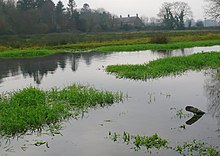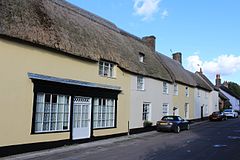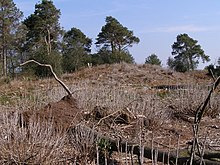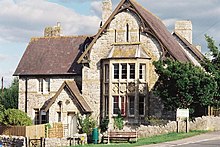Puddletown
| Puddletown | ||
|---|---|---|
| The Square | ||
| Coordinates | 50 ° 45 ′ N , 2 ° 21 ′ W | |
| OS National Grid | SY758943 | |
|
|
||
| Residents | 1452 | |
| administration | ||
| Post town | Puddletown | |
| ZIP code section | DT2 | |
| prefix | 01305 | |
| Part of the country | England | |
| region | South West England | |
| Ceremonial county | Dorset | |
| Unitary authority | Dorset | |
| British Parliament | West Dorset | |
Puddletown is a village in the Dorset Unitary Authority in England. The village is approximately 7 km (4.5 mi ) northeast of the town of Dorchester and takes its name from the River Piddle on the banks of which it stands. It used to be called Piddletown , but this name is no longer in use, because “piddle” also means “pee”. The name Puddletown was officially established in the late 1950s. The parish covers 7185 acres (2908 hectares) and extends to the River Frome in the south. In 2013 the place had an estimated 1450 inhabitants.
Puddletown Parish Church is architecturally interesting for its interior and tombs. It has a baptismal font from the 12th century and well-preserved woodwork, including “box pews” (pews) from the 17th century. Thomas Hardy was interested in the history of the Church and the village provided him with the inspiration for the fictional village of Weatherbury in his novel Far from the Madding Crowd ; Weatherbury Farm, the home of the main character Bathsheba Everdene, is designed after a local manor house .
The Puddletown Hundred included the towns of Athelhampton, Burleston, Milborne St Andrew, Puddletown, Tincleton and Tolpuddle.
Surname
The name Puddletown means "farmstead on the River Piddle". It comes from the Old English pidele , a river name meaning "swamp" or "marsh" and tūn , "farmyard". There are a number of settlements along the river that have a similar name. On the upper reaches of the river are Piddletrenthide and Piddlehinton , which have retained the original sound, while downstream Puddletown, Tolpuddle , Affpuddle , Briantspuddle and Turner's Puddle use the sound "puddle". Both forms have been used for puddletown over time. In the Domesday Book (1086) the place was drawn as Pitretone and in 1212 the spelling Pideleton was encountered . John Speed used the spelling "Puddletown" for his map of 1610. In 1848 Samuel Lewis again used "Piddletown" in his A Topographical Dictionary of England . In 1906 Sir Frederick Treves used Puddletown in Highways & Byways in Dorset and described the place as "the Town on the River Puddle" and a "curiously named place". In 1946 the name Piddletown reappeared on the electoral lists. One explanation for the preference for Puddletown over Piddletown is that Major-General Charles William Thompson , who lived at Ilsington Lodge after he had returned from World War II , forced the “puddle” variant, as “piddle” was a derogative in army circles Had meaning. The radio presenter and writer Ralph Wightman (1901-1971), a native of the Piddle Valley , traced the name variant back to the "refinement" of the Victorian era . He remembers that when he was young, old aunts also only addressed Piddletrenthide as "Trenthide". Roland Gant at Dorset Villages explained in detail that in Victorian times “puddle” was used in place of “piddle” because it had become a “euphemism for piss”. "Puddletown" was not officially enshrined in the 1950s when, according to Wightman, "a long county council debate came to the solemn resolution that Piddletown should become puddletown."
The other rivers in Parish have names of Celtic origin: the Frome , on the southern border of the Parish, means "beautiful, fine, clear" and the Devil's Brook on the northeast border means "dark stream".
geography

Puddletown Civil Parish stretches between the floodplain and floodplain meadows on the River Frome to the south of the watershed in the chalk area of Puddletown Down. It extends over 2,908 hectares (7185 acres ) and is divided in half by the River Piddle. The river runs through the Parish from west to east. Distances as the crow flies from Puddletown Village to Dorchester in the northeast is 7.2 km, Poole in the west is 26 km and Blandford Forum in the southwest is 18 km.
The bedrock of the area consists of chalk from the Santonian and Campanian eras and the Eocene of the Paleogene period. In places there are more recent deposits from the Quaternary : On river terraces and Head deposits there is a clay- flint mixture and alluvial soil . In Puddletown Heath (now mainly Puddletown Forest ) there are more than 370 sinkholes (solution hollows / sinkhole) - the largest collection of such holes in the moors around.
The River Frome, which forms the southern boundary of the Parish, has been designated a Site of Special Scientific Interest by Natural England . To the southwest of the village and almost entirely within the Parish area is Puddletown Forest, which covers 301 hectares (740 acres) and is administered by the Forestry Commission . The forest lies on the edge of the Dorset Heaths Natural Area and is partially being converted back into heathland; the heather plant community consists of Calluna , Ulex gallii ( gorse ), Ulex minor and bilberry ; to the particular animal species including the rare smooth snake (smooth snake) and sand lizards (sand lizard). Close to Puddletown Forest are Yellowham Wood and Ilsington Wood , which are designated as Ancient Woodland (before 1600).
history
Evidence of prehistoric human settlement in the Parish are around 30 Round Barrows , half of which were built on chalk underground and the other half over so-called "Reading Beds" of the Lambeth Group . Many of these tumuli have recently been damaged. The remains of Strip Lynchets (agricultural terraces ) of Celtic fields have been discovered near the Barrows. One of the three "Rainbarrows" at Duddle Heath has been excavated and the "bucket urns" with cremations are kept in the Dorset County Museum .
The Roman road between Durnovaria (Dorchester) and the Badbury Rings ran through what is now Parish; it ran on a WSW-ONO route through Puddletown Heath , between Puddletown Village and the Frome. It was not until our century that a section of the original road in Puddletown Forest that was 26 m (85 ft) wide was discovered.
Part of a 9th or 10th century stone cross was discovered when Styles House on the River Piddle was demolished. The cross could have been part of a meeting place. The fragment was integrated into the choir of the parish church when it was renewed in 1911.
The Domesday Book of 1086 lists Puddletown as a large and important manor , which included several villages with 1,600 sheep.
Except for Puddletown itself, the smaller settlements have all shrunk and disappeared. Well-known settlements were Cheselbourne Ford (at Devil's Brook in the northeast of Parish), Bardolfeston (about 1 km northeast of Puddletown Village, north of the River Piddle), Hyde (today: Druce Farm), Waterston , South Louvard (Higher Waterston), Little Piddle (Little Puddle Farm in neighboring Piddlehinton Parish) and Ilsington (in the south of Parish at Frome). Cheselbourne Ford and Bardolfeston are only deserted villages . Cheselbourne Ford had a population of 6 in 1086, only 4 in 1327 and abandoned by the mid-17th century. In 1970 traces of the place could still be found. The remains were scattered over an area of about 6 hectares and consisted of ten enclosures, which were bordered by low banquets. There are no longer any entries on modern Ordnance Survey maps. Records suggest that Bardolfeston was also shrinking as early as the 13th century, and although it was still inhabited in the 16th century, it was abandoned in the early 17th century. Its location is well preserved. The area covers approximately 6 hectares and is characterized by a 12 m wide (40 ft) ravine that runs from southwest to northeast and along which traces of at least eleven buildings can be found. The southern end of the site was destroyed, however, when meadow irrigation was created along the river . The Waterston site consists of two hectares of earthworks on a river terrace on the south bank of the River Piddle. The population was relatively stable through the Middle Ages and in 1662 there were ten households.
In the early 17th century, Puddletown was one of the first places in Dorset to introduce watermeadow. The form of cultivation began around 1620 and 1629 the Manorial Court ruled that some peasants should be allowed to create the necessary watercourses to "provide for the irrigation and improvement of their fields" (the watering and Improvinge of theire groundes). Meadow irrigation is no longer used, but parts of the irrigation systems are still recognizable; In the Civil Parish of Puddletown, several areas were mapped from watermeadows through 1978. In 2010 these entries disappeared.
Records from 1801 show that agriculture was the main branch of the economy at the time, but there were also cottage industries and handicrafts: 596 people in Parish were mainly employed in agriculture and 221 were artisans, manufacturers or traders. The cottage industry was mostly carried out by women and children and served to earn additional income, but the possibilities declined after the French Revolution .
In 1830, Puddletown was one of the places in Dorset where farm workers were involved in the Captain Swing riots in southern England. They protested against starvation wages and long working hours. Threshing machines were damaged and hay (ricks) ignited. As a result, wages were raised from six or seven shillings a week to ten.
To the east of the church is Ilsington House (Old Manor) from the late 17th to early 18th centuries. It originally belonged to the 3rd Earl of Huntingdon and from 1724 to Robert Walpole . Between 1780 and 1830 it was given to General Thomas Garth , who was then Rittmeister (principal equerry) of Georg III. leased. The general adopted King George III. illegitimate grandson of Princess Sophia , and raised him in the manor. In 1861 the house was purchased by John Brymer and remained in the Brymer family's possession for a century . The family built new cottages and a reading room in the village, as well as a new mansion by the church.
administration
In the UK Parliament , Puddletown is part of the West Dorset parliamentary constituency , currently represented by Oliver Letwin as a member of the Conservative Party . On site, Puddletown is part of Dorset County Council on the upper level, West Dorset District Council on the second level, and Puddletown Area Parish Council on the lowest level.
In the 24 constituencies of West Dorset, Puddletown is part of Puddletown ward . In county council elections, Puddletown is part of the Linden Lea Electoral Division .
population
In the United Kingdom Census 2011 Puddletown Parish was assessed together with the small Parish Athelhampton in the east; at that time there were 663 residential buildings, as well as 614 households and a population of 1,405. In 2014, the population of Puddletown civil parish was estimated at 1,452.
building
In addition to the old earthworks, 56 “structures” are listed within the Parish as listed buildings by Historic England . These include two (the parish church and Waterston Manor ) that have been classified as Grade I and three (Ilsington House, The Old Vicarage and 8 The Square) that have been classified as Grade II *.
Puddletown's parish church, consecrated to Mary , has been classified as "Particularly Architecturally Interesting" due to its special features and monuments, as well as one of the "most exciting parish churches in the county". It has parts of the tower dating back to the 12th century and the tower is dated to 1180–1200. However, it was renewed between the 13th and 16th centuries. The 12th century baptismal font is particularly noteworthy as it has the shape of a tapering beaker with damascene made of crossed trunks and acanthus leaves ; The lid is an octagonal pyramid from around 1635, from the time of the interior renovation of the church. There is a wooden ceiling paneling in the nave and pews (box pews) from the 17th century, as well as a pulpit and a gallery. The church also has a number of monumental bronzes from the 15th and 16th centuries, as well as some stained glass windows by Ninian Comper . The south chapel ("Martyn family chapel") has three tombs from the 16th century with alabaster figures . In 1910 the church was partially renovated in the style of the Victorian restoration by Charles Ponting . At that time Thomas Hardy led the unsuccessful fight against enlarging the chancel.
Waterston Manor , about 1.5 mi (2.4 km) west-northwest of Puddletown Village, dates from the early 17th century but was rebuilt after a fire in 1863, and remodeled again around 1911.
Ilsington House dates from the late 17th or early 18th centuries, with changes from the late 18th to early 19th centuries and an extension in the 19th century. It has plastered brick walls, cornerstones of stone (ashlar) and a hip roof . In 2000 it won the "Dorset Architectural Heritage Award".
The Old Vicarage , a building that used to be just the east wing of the Vicarage, was originally a timber frame building from around 1600. It was clad with bricks in the 18th century (after the Vicarage was expanded to the west in 1722) and a third floor was added in the 19th century. The 1722 extension became Building 8 The Square and is considered a separate building.
Village community
Puddletown has a Village Hall with a kitchen and bar and seating for 100 to 160 people. Since 2013, the Puddletown Community Library has also been located there , which is looked after by volunteers. In the Athelhampton Road there is a doctor's office (doctor's surgery). There is also a sports field on Three Lanes Way with a grass cricket pitch and two football pitches.
In the literature
Puddletown is the model for the village "Weatherbury" in Thomas Hardy's novel Far from the Madding Crowd . Weatherbury Farm, the home of Bathsheba Everdene, is modeled on Waterston Manor. Hardy's cousin, Tryphena Sparks , to whom the poem Thoughts of Phena at News of Her Death is dedicated, lived in Puddletown.
In JK Rowling's Harry Potter series there is the Quidditch team "Puddlemere United" as a team from near Puddletown, where the character Oliver Wood ibald is taken after his time at Hogwarts.
Personalities
- Reginald Pole (1500-1558), the last Roman Catholic Archbishop of Canterbury , served from 1532 to 1536 as vicar in the parish.
- Ralph Wightman (1901–1971), writer and television reporter, lived at 8 The Square.
- Constantine Fitzgibbon (1919–1983), owner of Waterston Manor.
Individual evidence
- ^ A b David Mills: A Dictionary of British Place Names. Oxford University Press 2011: 377. ISBN 978-0-19-960908-6
- ^ John Speed's Map of Dorset 1610. Charmouth Local History Society. May 13, 2017.
- ^ Samuel Lewis: A Topographical Dictionary of England. 1848. In: British History Online: 567-571. May 13, 2017.
- ^ Sir Frederick Treves: Highways & Byways in Dorset. Macmillan and Co. Ltd 1906: 365-366.
- ^ Wightman 1983: 70.
- ↑ a b c d e f g Clive Hannay; Rodney Legg: Puddletown Dorset Life Magazine, September 2006. August 23, 2015.
- ^ Wightman 1983: 70.
- ↑ Gant 1980: 188.
- ^ "A long County Council debate solemnly decided Piddletown should be Puddletown." Wightman 1983: 70; Gant 1980: 188.
- ↑ fair, fine or brisk. David Mills: A Dictionary of British Place Names. Oxford University Press 2011: 196. ISBN 978-0-19-960908-6
- ↑ dark stream. David Mills: A Dictionary of British Place Names. Oxford University Press 2011: 152. ISBN 978-0-19-960908-6
- ↑ a b c Ordnance Survey (1978) 1: 25,000 Second Series, Sheet SY 69/79 (Dorchester)
- ^ A b British Geological Survey (2000) 1: 50,000 Series, Sheet 328 (Dorchester), ISBN 0-7518-3310-X
- ↑ a b c d e f g h i 'Puddletown', in An Inventory of the Historical Monuments in Dorset. In: British History Online, Vol. 3, Central; University of London, London 1970: 222-231. March 1, 2015.
- ↑ Bartholomew (1980) 1: 100,000 National Map Series, Sheet 4 (Dorset) ISBN 0-7028-0327-8
- ^ AS Goudie, R. Gardner: Discovering Landscape in England & Wales. Springer Science & Business Media 2013 (1992): 136-137. ISBN 978-0-412-47850-5
- ↑ COUNTY: DORSET. SITE NAME: RIVER FROME. naturalengland.org.uk August 29, 2015.
- ↑ Plan name: Puddletown. Forestry Commission May 6, 2017.
- ^ Diarmuid MacDonagh: Roman road found in Puddletown Forest. Newsquest Media (Southern) Ltd, dorsetecho.co.uk January 29, 2011. August 31, 2015.
- ↑ John Baker; Stuart Brookes: Identifying outdoor assembly sites in early medieval England. In: Journal of Field Archeology 2015, 40. 1: 3-21. University of Nottingham . ISSN 0093-4690
- ^ Rosemary Cramp: Corpus of Anglo-Saxon Stone Sculpture: South-West England. British Academy 2006: 108. ISBN 978-0-19-726334-1
- ↑ JH Bettey: Dorset. David & Charles; City & County Histories 1974: 34-39. ISBN 0-7153-6371-9 .
- ^ Medieval settlement immediately west of Waterston House. Historic England May 29th 2017.
- ↑ Joseph H. Bettey: The Development of Water Meadows in Dorset during the Seventeenth Century. bahs.org.uk (British Agricultural History Society) (scan); August 27, 2015: 37-39.
- ↑ Joseph Bettey: Water management in the English Landscape. In: Hadrian Cook; Tom Williamson: The Development of Water Meadows in the Southern Counties. Edinburgh University Press 1999: 179-195.
- ^ Ordnance Survey (2010) 1: 25,000 Explorer Series, Sheet 117 (Cerne Abbas & Bere Regis), ISBN 978-0-319-24122-6
- ^ Susannah R. Ottaway: The Decline of Life: Old Age in Eighteenth-Century England. Cambridge University Press 2004: 191-192.
- ↑ Joseph H. Bettey: Dorset. David & Charles, City & County Histories 1974: 136-137. ISBN 0-7153-6371-9
- ^ A b Ilsington House, Puddletown. britishlistedbuildings.co.uk British Listed Buildings, 1st March 2015.
- ^ A b Adrianne Maslen: Dorset's Ilsington Estate on sale for £ 18million. Newsquest Media (Southern) Ltd dorsetecho.co.uk, July 7, 2010.
- ^ Wightman 1983: 75.
- ^ Welcome to the Puddletown Area Parish Council website. ( Memento of the original from March 4, 2016 in the Internet Archive ) Info: The archive link was inserted automatically and has not yet been checked. Please check the original and archive link according to the instructions and then remove this notice. Puddletown Area Parish Council. August 24, 2015.
- ^ The West Dorset (Electoral Changes) Order 2015. legislation.gov.uk August 10, 2015.
- ^ Dorset West: Seat, Ward and Prediction Details. ( Memento of the original from October 1, 2015 in the Internet Archive ) Info: The archive link was inserted automatically and has not yet been checked. Please check the original and archive link according to the instructions and then remove this notice. electoralcalculus.co.uk August 10, 2015.
- ↑ Interactive map of District Councilors. Dorset County Council, dorsetforyou.com August 10, 2015.
- ^ Electoral division profiles 2013. Dorset County Council dorsetforyou.com. 10 August 2015.
- ^ Area: Puddletown (Parish). Dwellings, Household Spaces and Accommodation Type, 2011 (KS401EW) Office for National Statistics. Neighborhood Statistics. March 1, 2015.
- ^ Area: Puddletown (Parish), Key Figures for 2011 Census: Key Statistics. Office for National Statistics | work = Neighborhood Statistics. March 16, 2014.
- ^ Dorset County Council. geowessex.com, Area Profile for Puddletown & Athelhampton December 25, 2016.
- ^ Listed Buildings in Puddletown, West Dorset, Dorset. britishlistedbuildings.co.uk May 31, 2017.
- ↑ 'Puddletown'. Historic England June 4th 2017.
- ↑ being of considerable architectural interest, inventory.
- ↑ of exceptional interest for its furnishings and monuments. Church of Saint Mary, Puddletown. britishlistedbuildings.co.uk August 26, 2015.
- ↑ one of the most exciting parish churches in the county. Puddletown St Mary's. ( Memento of the original from September 23, 2015 in the Internet Archive ) Info: The archive link was inserted automatically and has not yet been checked. Please check the original and archive link according to the instructions and then remove this notice. The Dorset Historic Churches Trust August 26, 2015.
- ↑ John Betjeman (ed.): Collins Pocket Guide to English Parish Churches; the South . London: Collins 1968: 176.
- ^ Waterston Manor, Puddletown. britishlistedbuildings.co.uk, August 24, 2015.
- ^ The Old Vicarage Including Garden Walls Adjoining Islington House, Puddletown. britishlistedbuildings.co.uk August 26, 2015.
- ^ The Square, Puddletown. britishlistedbuildings.co.uk, August 26, 2015.
- ^ Puddletown Village Hall. Dorset Village Halls Association. Dorset Halls Network August 30th 2015.
- ↑ Welcome to Puddletown Community Library. communitylibrarypuddletown.org August 31, 2015.
- ^ Puddletown Surgery. puddletownsurgery.co.uk August 31, 2015.
- ^ Puddletown Recreation Ground. sports-facilities.co.uk August 30, 2015.
- ↑ Gant 1980: 190.
- ↑ Michael Millgate: Thomas Hardy: a biography revisited. Oxford University Press 2004. ISBN 0-19-927566-1
- ↑ Gant 1980: 190.
literature
- Roland Gant: Dorset Villages. Robert Hale Ltd 1980. ISBN 0-7091-8135-3
- Ralph Wightman: Portrait of Dorset. Robert Hale Ltd 1983. ISBN 0-7090-0844-9





